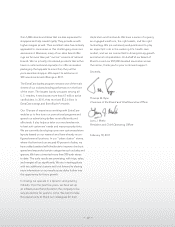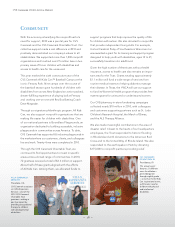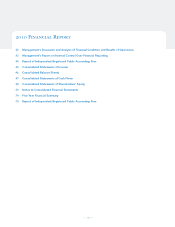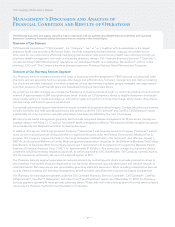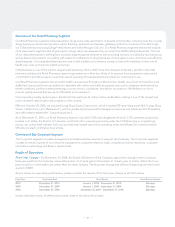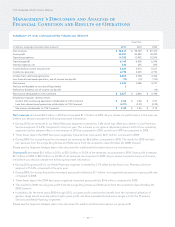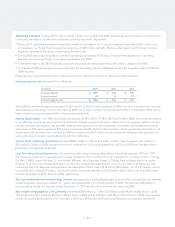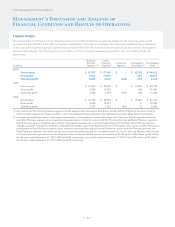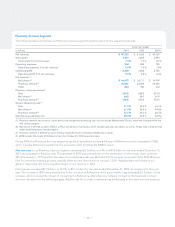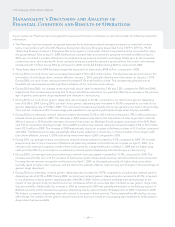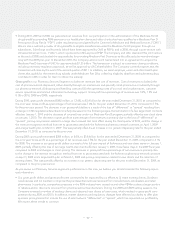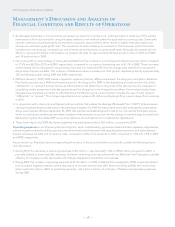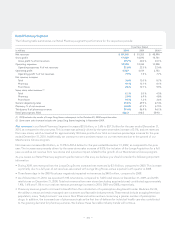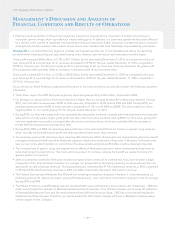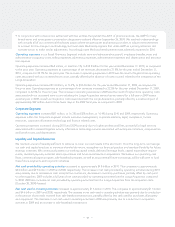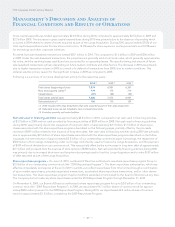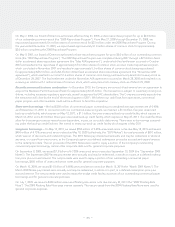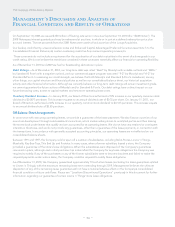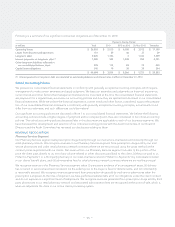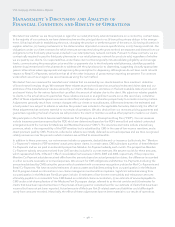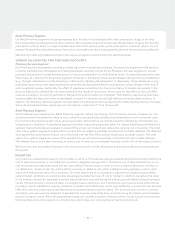CVS 2010 Annual Report Download - page 31
Download and view the complete annual report
Please find page 31 of the 2010 CVS annual report below. You can navigate through the pages in the report by either clicking on the pages listed below, or by using the keyword search tool below to find specific information within the annual report.
• During 2010, 2009 and 2008, we generated net revenues from our participation in the administration of the Medicare Part D
drug benefit by providing PBM services to our health plan clients and other clients that have qualified as a Medicare Part D
Prescription Drug Plan (a “PDP”) under regulations promulgated by the Centers for Medicare and Medicaid Services (“CMS”).
We are also a national provider of drug benefits to eligible beneficiaries under the Medicare Part D program through our
subsidiaries, SilverScript and Accendo (which have been approved by CMS as PDPs), and in 2008, through a joint venture with
Universal American Corp. (“UAC”), which sponsored a CMS approved PDP. The Company and UAC dissolved this joint venture
at the end of 2008 and divided the responsibility for providing Medicare Part D services to the affected plan members begin-
ning with the 2009 plan year. In December 2010, the Company announced it had entered into an agreement to acquire the
Medicare Part D business of UAC for approximately $1.25 billion. The transaction is subject to customary closing conditions,
including necessary regulatory approvals, as well as approval by UAC shareholders. The Company currently expects that the
transaction will close by the end of the second quarter of 2011. In addition, we assist employer, union and other health plan
clients that qualify for the retiree drug subsidy under Medicare Part D by collecting eligibility data from and submitting drug
cost data to CMS in order for them to obtain the subsidy.
Gross profit in our Pharmacy Services Segment includes net revenues less cost of revenues. Cost of revenues includes (i) the
cost of pharmaceuticals dispensed, either directly through our mail service and specialty retail pharmacies or indirectly through
our pharmacy network, (ii) shipping and handling costs and (iii) the operating costs of our mail service pharmacies, customer
service operations and related information technology support. Gross profit as a percentage of revenues was 7.0%, 7.5% and
8.1% in 2010, 2009 and 2008, respectively.
During 2010, gross profit decreased $482 million, or 12.6%, to $3.4 billion for the year ended December 31, 2010, as compared to
the prior year. Gross profit as a percentage of net revenues was 7.0% for the year ended December 31, 2010, compared to 7.5%
for the prior year period. The decrease in our gross profit dollars is a result of the loss of “differential” or “spread” resulting from
a change in CMS regulations described more fully discussed on the following pages, the termination of a few large client contracts
effective January 1, 2010 and the decrease of covered lives under our Medicare Part D program, partially offset by new client starts
on January 1, 2010. The decrease in gross profit as a percentage of net revenues is primarily due to the loss of “differential” or
“spread”, pricing compression related to a large client renewal that took effect during the third quarter of 2010, and the change in
the revenue recognition method from net to gross associated with the RxAmerica pharmacy network contracts on April 1, 2009
and a large health plan on March 1, 2009. This was partially offset by an increase in our generic dispensing rate for the year ended
December 31, 2010, as compared to the prior year.
During 2009, gross profit increased $285 million, or 8.0%, to $3.8 billion for the year ended December 31, 2009, as compared to
the prior year. Gross profit as a percentage of net revenues was 7.5% for the year ended December 31, 2009, compared to 8.1%
for 2008. The increase in our gross profit dollars is a result of the full year impact of RxAmerica and new client starts on January 1,
2009, partially offset by the loss of two large health plan clients effective January 1, 2009, three fewer days in the 2009 fiscal year
compared to 2008 and changes in client pricing. The decrease in gross profit as a percentage of net revenues is primarily due
to the change in the revenue recognition method from net to gross associated with the RxAmerica pharmacy network contracts
on April 1, 2009 and a large health plan on March 1, 2009 and pricing compression related to new clients and the retention of
existing clients. This was partially offset by an increase in our generic dispensing rate for the year ended December 31, 2009, as
compared to the prior year period.
As you review our Pharmacy Services segment’s performance in this area, we believe you should consider the following impor-
tant information:
• Our gross profit dollars and gross profit rates continued to be impacted by our efforts to (i) retain existing clients, (ii) obtain
new business and (iii) maintain or improve the purchase discounts we received from manufacturers, wholesalers and retail
pharmacies. In particular, competitive pressures in the PBM industry have caused us and other PBMs to share a larger portion
of rebates and/or discounts received from pharmaceutical manufacturers. During the 2008 and 2009 selling seasons, the
Company renewed a number of existing clients and obtained new clients at lower rates, which resulted in gross profit com-
pression during 2009, and 2010. In addition, market dynamics and regulatory changes have affected our ability to offer plan
sponsors pricing terms that include the use of retail network “differential” or “spread”, which has impacted our profitability.
We expect these trends to continue.
– 27 –


